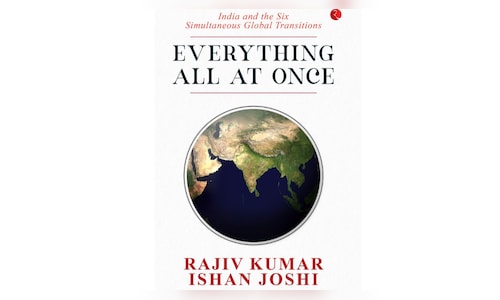It is into this landscape that Everything All At Once, co-authored by economist and former NITI Aayog Vice-Chairman Dr Rajiv Kumar and journalist-policy analyst Ishan Joshi, offers its intervention. Rather than a prescriptive plan, the book frames India’s central task as coherence: crafting a strategy resilient enough to absorb shocks yet agile enough to recalibrate in a shifting world.
At its heart lies a demanding thesis: India must grapple with six deeply intertwined global transitions — geopolitical, geoeconomic, technological, ecological, demographic and ideological. A rebalanced global order requires India to rethink alliances and build new coalitions. The move from hyper-globalisation to trusted trade corridors forces tough choices on supply chains. The AI and biotech revolutions could redraw the very basis of comparative advantage. The climate imperative demands the near-impossible: rapid growth while lowering emissions. Demographic shifts could turn today’s dividend into tomorrow’s burden if job creation falters. And an ideological contest over what “development” should mean pushes India to define its own path.
Fragmented, sequential responses won’t meet these challenges. Instead, the authors argue for an integrated strategy that sees India not only adapting to global change but shaping it. Here, the book’s narrative stands apart: it refuses to cast India as merely a passive recipient of global trends, instead seeing the nation as both a taker and a shaper. Equally important, the book avoids turning “Viksit Bharat” into political poster. It asks what it should mean to be “developed”: These questions they ask in the book on this, will push the readers to confront real trade-offs: speed versus sustainability, growth versus equity, integration versus resilience.
The authors also highlight where India already shapes outcomes: digital public infrastructure like Aadhaar and UPI now admired globally; bold bets on green technologies like hydrogen; and active convening in new Indo-Pacific economic and security frameworks. They remind us this agency is neither accidental nor assured. It requires building coalitions, crafting narratives and investing in institutional capability — choices that see complexity not as a reason for hesitation, but as the strategic ground where India must operate.
Importantly, the book sees beyond government alone. India’s global posture is shaped in entrepreneurs, boardrooms, academia, research labs and by its diaspora. This multi-stakeholder perspective adds realism often missing from policy commentary.
Equally, the authors show how India’s story is built from the ground up: local entrepreneurs, civic institutions and district-level innovation shape outcomes as much as national policy. Whether in urban water resilience projects, renewable clusters or social enterprises bridging health and education gaps, these decentralised efforts transform ambition into daily practice.
Yet the book is candid about hard constraints. Can policy frameworks stay nimble as disruption quickens? Will short-term electoral cycles eclipse long-term strategy? Can formalisation, capacity building and social policy keep pace with urbanisation, ageing and technological change? The authors warn that while global volatility can’t be wished away, domestic rigidity can — and must — be addressed.
The narrative surfaces many deeper policy conundrums, and they are not technocratic questions but choices that will define the pace, character and fairness of India’s rise.
Stylistically, the book impresses: measured yet urgent prose, clear of jargon, and data that supports rather than dominates. Each chapter explores one transition before drawing them together, offering newcomers an accessible entry point and seasoned readers a framework to challenge and refine.
In the end, Everything All At Once is neither a forecast nor a manifesto. It reminds us India’s task is not merely to keep up with a turbulent world but to remain coherent as that world fragments — and to define progress in ways that balance ambition, inclusion and environmental responsibility.
For policymakers, business leaders and engaged citizens, the book offers timely reflection: India’s future will not be shaped just by reacting to global currents, but by deciding — together and deliberately — what kind of development truly matters.
(Edited by : Unnikrishnan)
First Published: Aug 5, 2025 1:21 AM IST

